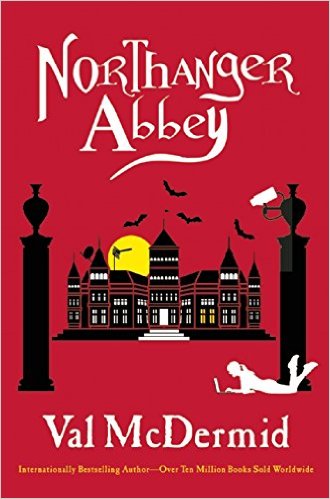Northanger Abbey, by Val McDermid
Apr 18
2016

Val McDermid's Northanger Abbey is the second installment in the Austen Project, HarperCollins's much-maligned attempt to produce modern re-workings of Jane Austen's six novels, each written by a popular current author. As I mentioned in my review of Alexander McCall Smith's take on Emma, this is an exceptionally tall order: while many aspects of Austen's books are timeless, not all of her work makes sense in a 21st century setting.
In McDermid's book, 17-year-old Cat Morland is thrilled when her neighbors invite her to accompany them on a trip to the Edinburgh Festival Fringe. As the home-schooled daughter of a minister, Cat has lived a sheltered existence, spiced up mostly by her passionate love of vampire romance novels. Edinburgh is a whole new world to her, full of flirtation, new friends, and social pitfalls. When Cat meets handsome Henry Tilney and his sweet sister Eleanor, she has nothing left to wish for—but over time, she finds herself wondering if the Tilney siblings' seeming perfection is a cover for something much darker.
McDermid writes with easy good-humor, and there is plenty to enjoy about this novel. I genuinely liked her take on Austen's heroine (although her Cat seems quite a bit stupider than the original Catherine), and she has a gift for making even direct updates of Austen's writing sound unforced. Check out these parallel descriptions of the Thorpe sisters:
Jane Austen's version:
At this point, I'm going to launch into a more in-depth criticism of McDermid's reading of the original Northanger Abbey. If you're a casual Austen fan, you can totally stop reading—the above paragraphs serve as our review, and the rest of this stuff is both spoiler-ridden and super nerdy.
I fundamentally disagree with McDermid's decision to equate the original heroine's love of Gothic novels with modern-day paranormal romance. In Austen's book, Catherine loves Ann Radcliffe novels, which feature exotic landscapes, wild adventures, and cartoonish characters. It's a natural fit for her character, offering her a glimpse of a more exciting (albeit far-fetched) world. But it's important to understand that Radcliffe always included a rational explanation for the seemingly supernatural events in her books, which means that Catherine's Radcliffe-inspired misconception about the Tilney family is at least possible, if not plausible. But when McDermid replaces Gothic novels with vampire books, she asks us to accept that Cat is worried that the Tilneys are literal vampires. That's several steps past the original Catherine's level of gullibility, and it does the character a major disservice.
In McDermid's book, 17-year-old Cat Morland is thrilled when her neighbors invite her to accompany them on a trip to the Edinburgh Festival Fringe. As the home-schooled daughter of a minister, Cat has lived a sheltered existence, spiced up mostly by her passionate love of vampire romance novels. Edinburgh is a whole new world to her, full of flirtation, new friends, and social pitfalls. When Cat meets handsome Henry Tilney and his sweet sister Eleanor, she has nothing left to wish for—but over time, she finds herself wondering if the Tilney siblings' seeming perfection is a cover for something much darker.
McDermid writes with easy good-humor, and there is plenty to enjoy about this novel. I genuinely liked her take on Austen's heroine (although her Cat seems quite a bit stupider than the original Catherine), and she has a gift for making even direct updates of Austen's writing sound unforced. Check out these parallel descriptions of the Thorpe sisters:
Jane Austen's version:
“[Mrs. Thorpe's] eldest daughter had great personal beauty, and the younger ones, by pretending to be as handsome as their sister, imitating her air, and dressing in the same style, did very well.”McDermid's version:
“[The Thorpe sisters] looked as if they'd popped out of the same mould, each having slightly less clean-cut lines than the previous sister... All three had identical tawny hair and eyes of a blue that is sometimes described as icy but which Cat preferred to think of as Scandinavian, having watched too many subtitled TV detective serials.”Unfortunately, McDermid is frequently handicapped by her attempt to stick as closely as possible to her source material (like when she maintains Catherine and Henry's 7-year age difference, which may have been unremarkable 200 years ago, but is straight-up creepy today). She incorporates these anachronisms as gracefully as possible, but they're a persistent distraction. But even with its many flaws, this is a far more entertaining effort than Smith's Emma, and does an infinitely better job of capturing the charm of Austen's novel.
At this point, I'm going to launch into a more in-depth criticism of McDermid's reading of the original Northanger Abbey. If you're a casual Austen fan, you can totally stop reading—the above paragraphs serve as our review, and the rest of this stuff is both spoiler-ridden and super nerdy.
I fundamentally disagree with McDermid's decision to equate the original heroine's love of Gothic novels with modern-day paranormal romance. In Austen's book, Catherine loves Ann Radcliffe novels, which feature exotic landscapes, wild adventures, and cartoonish characters. It's a natural fit for her character, offering her a glimpse of a more exciting (albeit far-fetched) world. But it's important to understand that Radcliffe always included a rational explanation for the seemingly supernatural events in her books, which means that Catherine's Radcliffe-inspired misconception about the Tilney family is at least possible, if not plausible. But when McDermid replaces Gothic novels with vampire books, she asks us to accept that Cat is worried that the Tilneys are literal vampires. That's several steps past the original Catherine's level of gullibility, and it does the character a major disservice.
Posted by: Julianka
No new comments are allowed on this post.
Comments
No comments yet. Be the first!